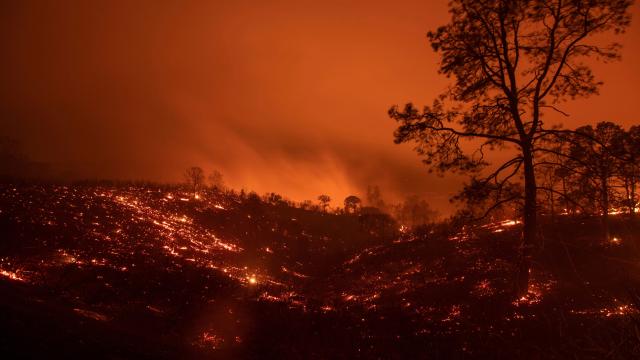An enormous bushfire in northern California has become the largest on record for the state, less than a year after the Thomas Fire in southern California earned that dubious distinction. It’s the latest reminder that we now live in an era of fast-growing, hard-to-contain megafires.
The Mendocino Complex fire, which includes the Ranch and River fires burning side by side in Lake and Mendocino counties, currently stands at a combined 283,800 acres, placing it above the Thomas Fire as the largest bushfire in modern Californian history.
Containment remains low, and the fires are still growing. Considering the conditions, state officials believed it highly possible that the fire would overtake the Thomas Fire.
“Look how big it got, just in a matter of days,” Scott McLean, a deputy chief with the California Department of Forestry and Fire Protection (CalFire), told the LA Times. “Look how fast this Mendocino Complex went up in ranking. That doesn’t happen. That just doesn’t happen.”
Indeed, the fires exploded into existence just 10 days ago on July 27, and have been consuming land at breakneck speed. The larger of the two — the Ranch Fire — makes the top 10 list in its own right. As of yesterday, the blaze had torched 225,000 acres and was just 21 per cent contained. The River Fire, meanwhile, was closing in on 50,000 acres and nearly 60 per cent containment.
Thousands of personnel are working to contain the fires, which together threaten thousands of structures. But with scorching temperatures and little rain on tap for the next few days, they may prove hard to stamp out.
Over the weekend, President Donald Trump declared a “major disaster” in California, ordering that federal funds be made available to help the state cope with its destructive blazes and help residents affected by the Carr Fire, another enormous bushfire burning not too far away in Shasta and Trinity counties.
Trump also took to Twitter to blame California’s “bad environmental laws” for the situation, and to falsely assert that the state is somehow diverting water it could be using to fight fires into the ocean. So, there’s that.
The truth is that mega-fires such as the Mendocino Complex are increasingly becoming the norm in the US West thanks to a combination of more humans living at the bushland-urban interface, persistent drought, misguided policies that caused large amounts of vegetation (AKA fire fuel) to build up on landscapes, and climate change.
“Our contribution to climate warming has effectively made fuels 50% drier and doubled the amount of western forests that have burned since 1984,” Jennifer Balch, a fire ecologist at the University of Colorado Boulder, told us via email.
John Abatzoglou, a climate scientist at the University of Idaho, noted several climate and weather factors that set the stage for the Mendocino Complex conflagration. There was the very wet winter of 2016-2017, which “helped created a bumper crop of grasses last summer,” as Abatzoglou put it in an email. This year’s fire season has been incredibly dry, with unusually hot nights since July that have inhibited fire-suppression activities.
Abatzoglou also pointed to the long-term trend, noting that the dryness of fire fuels and frequency of hot nights have trended upwards in recent years.
The rise in extreme fire activity across the US West has been on display over and over in recent months, and it’s clear we the US needs to get its crap together. A bushfire fix in the 2018 omnibus spending bill was a step in the right direction, allowing US federal agencies to access disaster funds rather than tapping their normal budgets to deal with the biggest blazes.
But there’s still plenty more work to do, from allocating additional resources toward removing vegetation on bushfire-prone landscapes to setting and enforcing strong building codes to holding those who start fires accountable. People could also try doing something about climate change.
